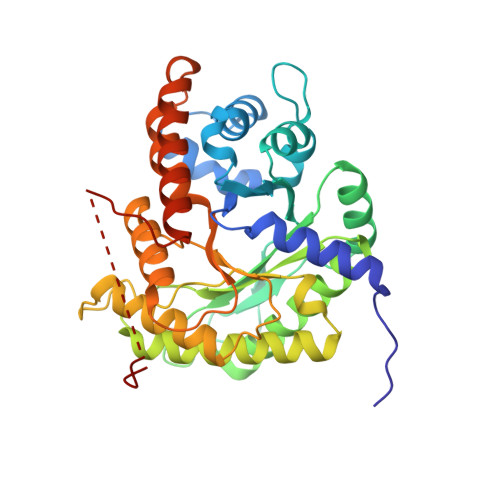Stereospecific proton transfer by a mobile catalyst in mammalian fructose-1,6-bisphosphate aldolase
St-Jean, M., Sygusch, J.(2007) J Biol Chem 282: 31028-31037
- PubMed: 17728250
- DOI: https://doi.org/10.1074/jbc.M704968200
- Primary Citation of Related Structures:
2QUT, 2QUU, 2QUV - PubMed Abstract:
Class I fructose-1,6-bisphosphate aldolases catalyze the interconversion between the enamine and iminium covalent enzymatic intermediates by stereospecific exchange of the pro(S) proton of the dihydroxyacetone-phosphate C3 carbon, an obligatory reaction step during substrate cleavage. To investigate the mechanism of stereospecific proton exchange, high resolution crystal structures of native and a mutant Lys(146) --> Met aldolase were solved in complex with dihydroxyacetone phosphate. The structural analysis revealed trapping of the enamine intermediate at Lys(229) in native aldolase. Mutation of conserved active site residue Lys(146) to Met drastically decreased activity and enabled trapping of the putative iminium intermediate in the crystal structure showing active site attachment by C-terminal residues 360-363. Attachment positions the conserved C-terminal Tyr(363) hydroxyl within 2.9A of the C3 carbon in the iminium in an orientation consistent with incipient re face proton transfer. We propose a catalytic mechanism by which the mobile C-terminal Tyr(363) is activated by the iminium phosphate via a structurally conserved water molecule to yield a transient phenate, whose developing negative charge is stabilized by a Lys(146) positive charge, and which abstracts the C3 pro(S) proton forming the enamine. An identical C-terminal binding mode observed in the presence of phosphate in the native structure corroborates Tyr(363) interaction with Lys(146) and is consistent with transient C terminus binding in the enamine. The absence of charge stabilization and of a mobile C-terminal catalyst explains the extraordinary stability of enamine intermediates in transaldolases.
Organizational Affiliation:
Department of Biochemistry, Université de Montréal, Montréal, Québec H3C 3J7, Canada.















